Comprehensive Financial Performance and Position Analysis Report
VerifiedAdded on 2023/01/12
|7
|1572
|79
Report
AI Summary
This report presents a comprehensive financial analysis of a company's performance and position based on its 2033 and 2032 financial statements and key financial ratios. The analysis delves into the company's profitability, efficiency, liquidity, and stability, offering insights into its financial health. Profitability is assessed through ratios like Return on Capital Employed (ROCE), Gross Profit Margin, and Operating Profit Margin, highlighting the company's significant improvement in ROCE from negative to positive values and the increase in gross profit margins. Efficiency is evaluated through inventory holding period, trade receivables period, and payment period to suppliers, revealing effective inventory management but challenges in managing the cash cycle due to high receivables. Liquidity is examined using current and acid-test ratios, indicating a weak liquidity position. Stability is analyzed through the gearing ratio and interest coverage ratio, showing high debt levels and improved interest coverage. The report concludes with recommendations for improving the company's liquidity position and maintaining its profitability.
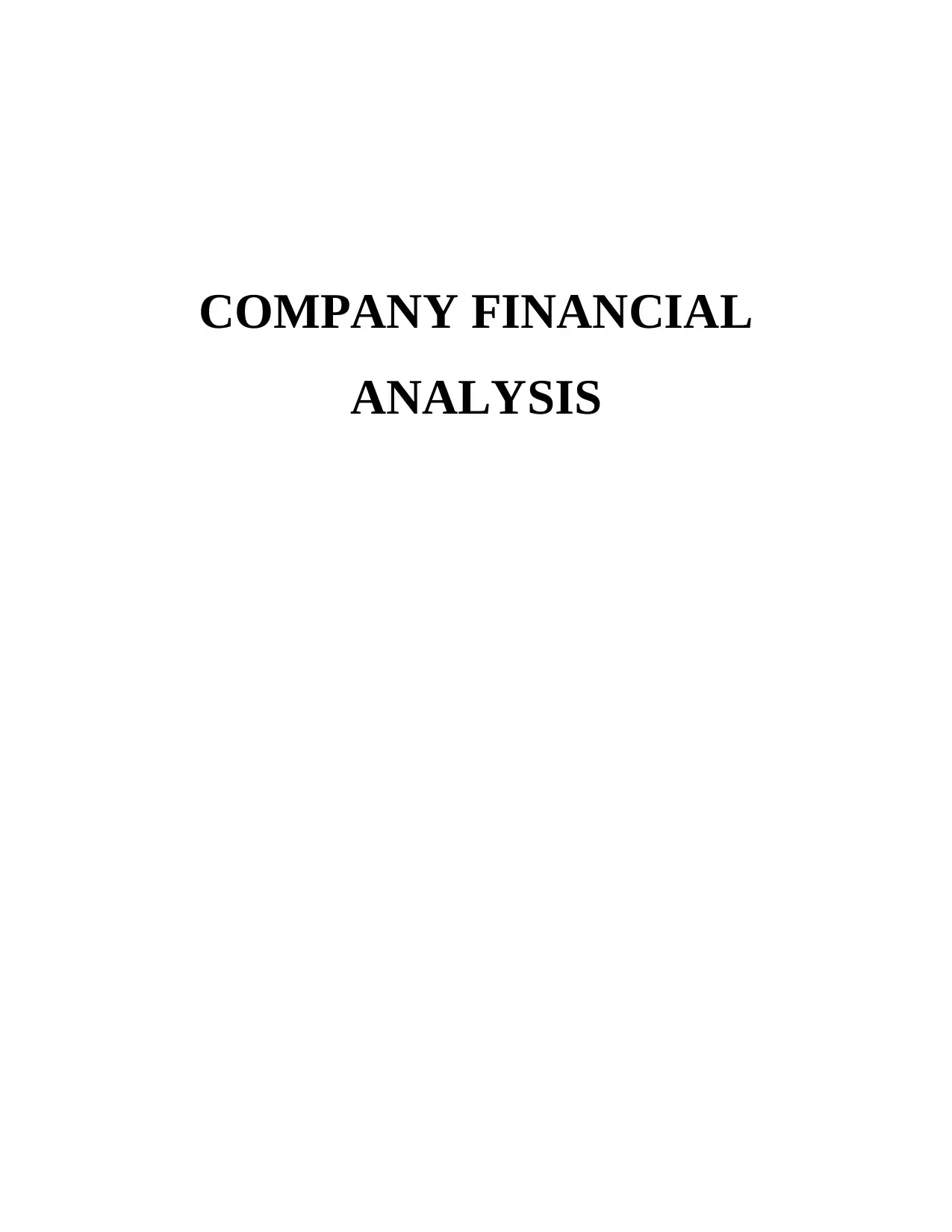
COMPANY FINANCIAL
ANALYSIS
ANALYSIS
Paraphrase This Document
Need a fresh take? Get an instant paraphrase of this document with our AI Paraphraser
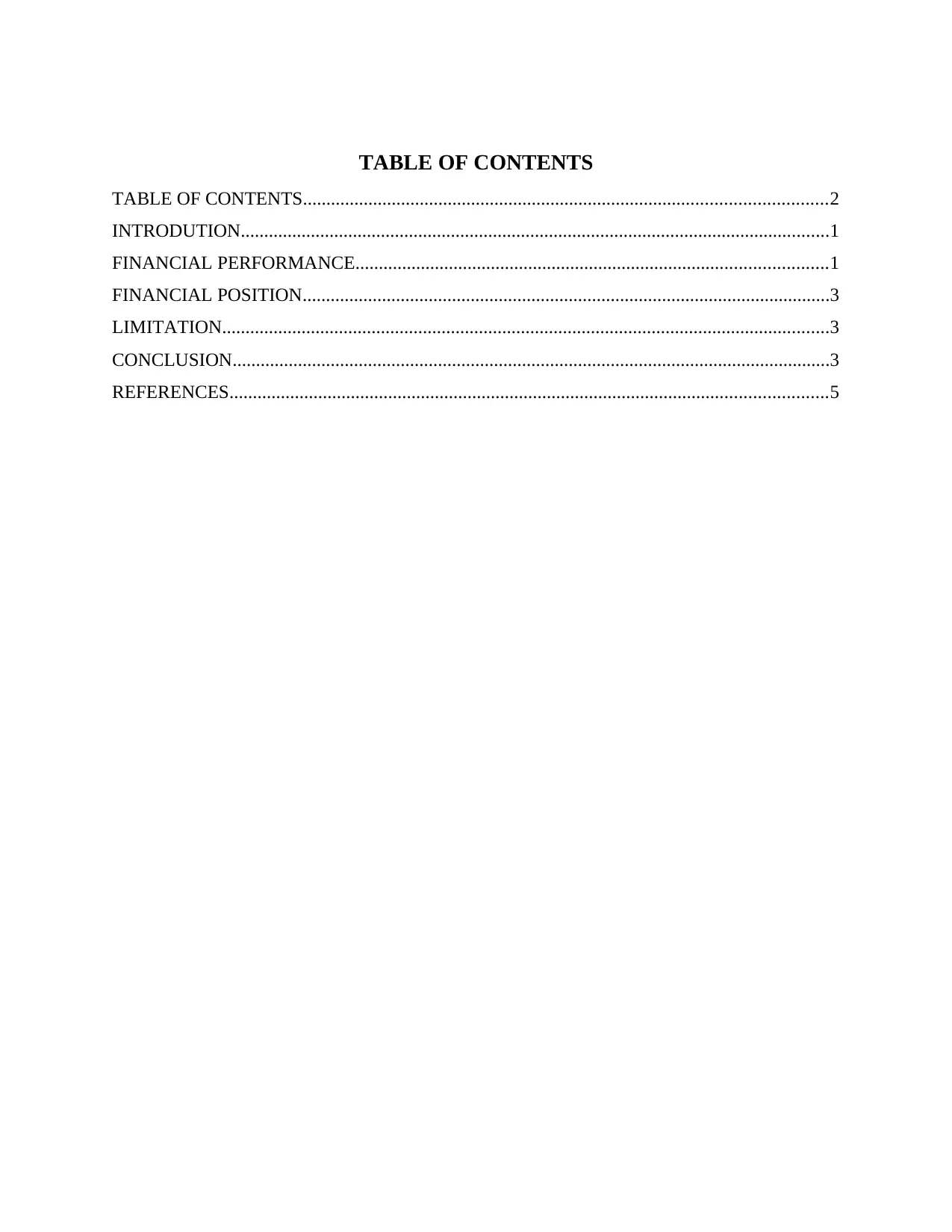
TABLE OF CONTENTS
TABLE OF CONTENTS................................................................................................................2
INTRODUTION..............................................................................................................................1
FINANCIAL PERFORMANCE.....................................................................................................1
FINANCIAL POSITION.................................................................................................................3
LIMITATION..................................................................................................................................3
CONCLUSION................................................................................................................................3
REFERENCES................................................................................................................................5
TABLE OF CONTENTS................................................................................................................2
INTRODUTION..............................................................................................................................1
FINANCIAL PERFORMANCE.....................................................................................................1
FINANCIAL POSITION.................................................................................................................3
LIMITATION..................................................................................................................................3
CONCLUSION................................................................................................................................3
REFERENCES................................................................................................................................5
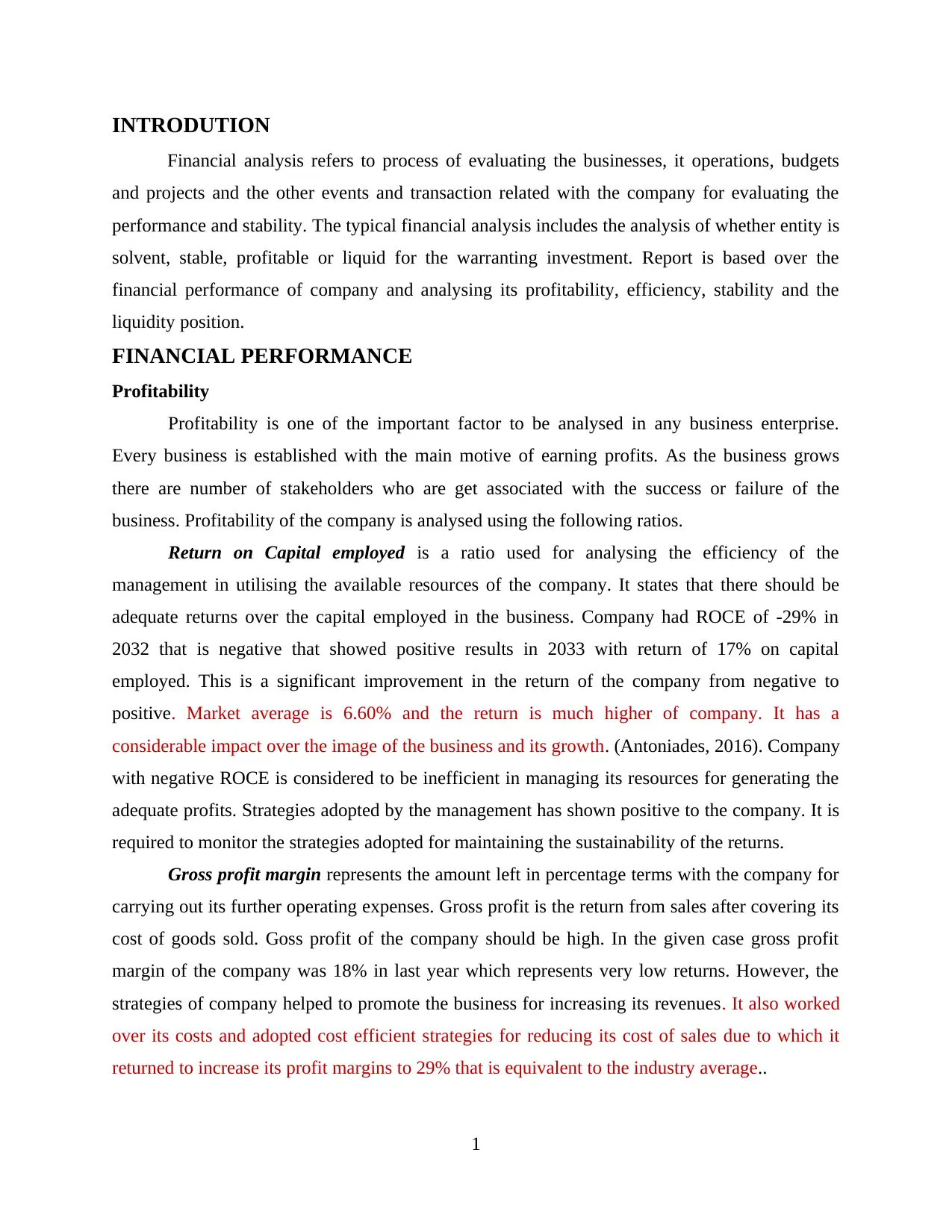
INTRODUTION
Financial analysis refers to process of evaluating the businesses, it operations, budgets
and projects and the other events and transaction related with the company for evaluating the
performance and stability. The typical financial analysis includes the analysis of whether entity is
solvent, stable, profitable or liquid for the warranting investment. Report is based over the
financial performance of company and analysing its profitability, efficiency, stability and the
liquidity position.
FINANCIAL PERFORMANCE
Profitability
Profitability is one of the important factor to be analysed in any business enterprise.
Every business is established with the main motive of earning profits. As the business grows
there are number of stakeholders who are get associated with the success or failure of the
business. Profitability of the company is analysed using the following ratios.
Return on Capital employed is a ratio used for analysing the efficiency of the
management in utilising the available resources of the company. It states that there should be
adequate returns over the capital employed in the business. Company had ROCE of -29% in
2032 that is negative that showed positive results in 2033 with return of 17% on capital
employed. This is a significant improvement in the return of the company from negative to
positive. Market average is 6.60% and the return is much higher of company. It has a
considerable impact over the image of the business and its growth. (Antoniades, 2016). Company
with negative ROCE is considered to be inefficient in managing its resources for generating the
adequate profits. Strategies adopted by the management has shown positive to the company. It is
required to monitor the strategies adopted for maintaining the sustainability of the returns.
Gross profit margin represents the amount left in percentage terms with the company for
carrying out its further operating expenses. Gross profit is the return from sales after covering its
cost of goods sold. Goss profit of the company should be high. In the given case gross profit
margin of the company was 18% in last year which represents very low returns. However, the
strategies of company helped to promote the business for increasing its revenues. It also worked
over its costs and adopted cost efficient strategies for reducing its cost of sales due to which it
returned to increase its profit margins to 29% that is equivalent to the industry average..
1
Financial analysis refers to process of evaluating the businesses, it operations, budgets
and projects and the other events and transaction related with the company for evaluating the
performance and stability. The typical financial analysis includes the analysis of whether entity is
solvent, stable, profitable or liquid for the warranting investment. Report is based over the
financial performance of company and analysing its profitability, efficiency, stability and the
liquidity position.
FINANCIAL PERFORMANCE
Profitability
Profitability is one of the important factor to be analysed in any business enterprise.
Every business is established with the main motive of earning profits. As the business grows
there are number of stakeholders who are get associated with the success or failure of the
business. Profitability of the company is analysed using the following ratios.
Return on Capital employed is a ratio used for analysing the efficiency of the
management in utilising the available resources of the company. It states that there should be
adequate returns over the capital employed in the business. Company had ROCE of -29% in
2032 that is negative that showed positive results in 2033 with return of 17% on capital
employed. This is a significant improvement in the return of the company from negative to
positive. Market average is 6.60% and the return is much higher of company. It has a
considerable impact over the image of the business and its growth. (Antoniades, 2016). Company
with negative ROCE is considered to be inefficient in managing its resources for generating the
adequate profits. Strategies adopted by the management has shown positive to the company. It is
required to monitor the strategies adopted for maintaining the sustainability of the returns.
Gross profit margin represents the amount left in percentage terms with the company for
carrying out its further operating expenses. Gross profit is the return from sales after covering its
cost of goods sold. Goss profit of the company should be high. In the given case gross profit
margin of the company was 18% in last year which represents very low returns. However, the
strategies of company helped to promote the business for increasing its revenues. It also worked
over its costs and adopted cost efficient strategies for reducing its cost of sales due to which it
returned to increase its profit margins to 29% that is equivalent to the industry average..
1
⊘ This is a preview!⊘
Do you want full access?
Subscribe today to unlock all pages.

Trusted by 1+ million students worldwide
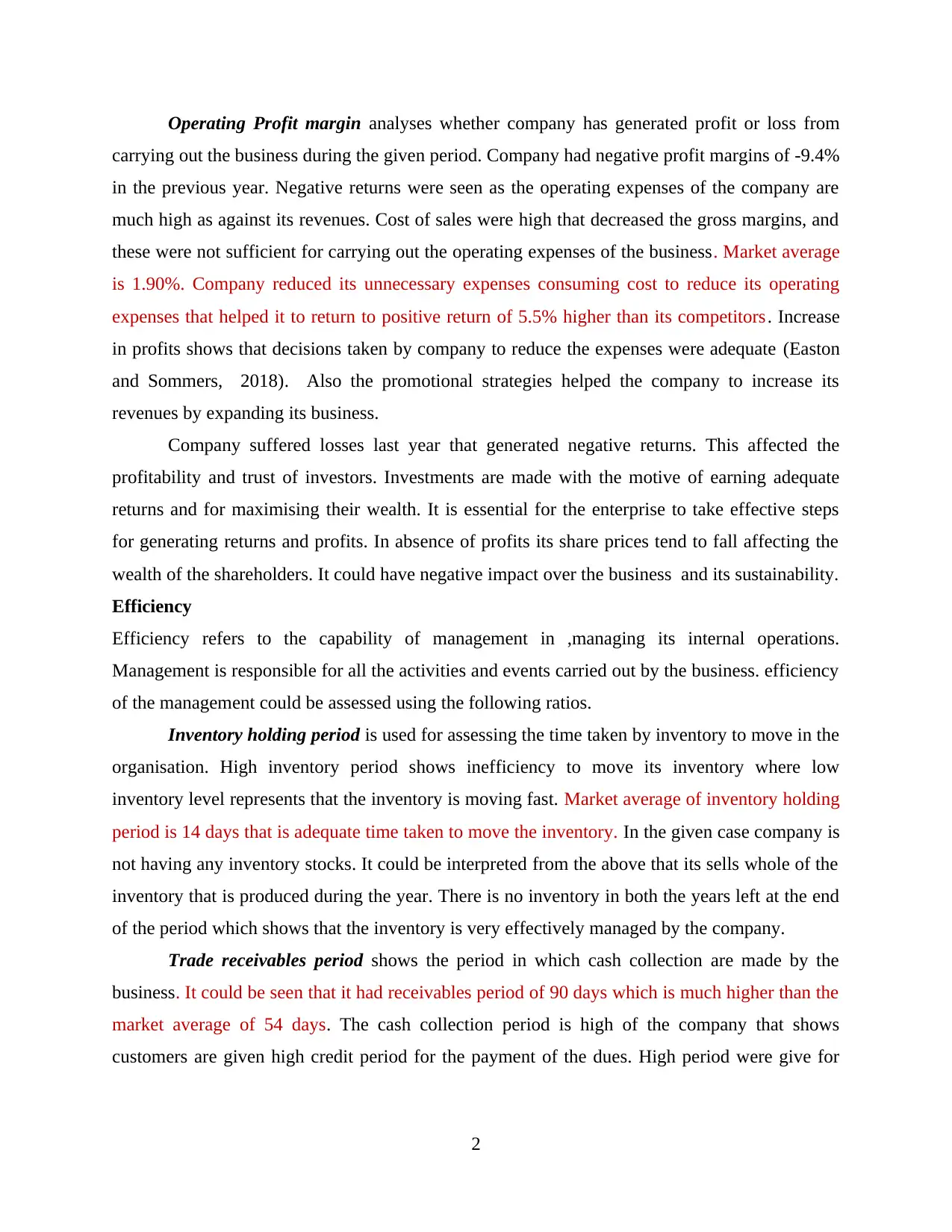
Operating Profit margin analyses whether company has generated profit or loss from
carrying out the business during the given period. Company had negative profit margins of -9.4%
in the previous year. Negative returns were seen as the operating expenses of the company are
much high as against its revenues. Cost of sales were high that decreased the gross margins, and
these were not sufficient for carrying out the operating expenses of the business. Market average
is 1.90%. Company reduced its unnecessary expenses consuming cost to reduce its operating
expenses that helped it to return to positive return of 5.5% higher than its competitors. Increase
in profits shows that decisions taken by company to reduce the expenses were adequate (Easton
and Sommers, 2018). Also the promotional strategies helped the company to increase its
revenues by expanding its business.
Company suffered losses last year that generated negative returns. This affected the
profitability and trust of investors. Investments are made with the motive of earning adequate
returns and for maximising their wealth. It is essential for the enterprise to take effective steps
for generating returns and profits. In absence of profits its share prices tend to fall affecting the
wealth of the shareholders. It could have negative impact over the business and its sustainability.
Efficiency
Efficiency refers to the capability of management in ,managing its internal operations.
Management is responsible for all the activities and events carried out by the business. efficiency
of the management could be assessed using the following ratios.
Inventory holding period is used for assessing the time taken by inventory to move in the
organisation. High inventory period shows inefficiency to move its inventory where low
inventory level represents that the inventory is moving fast. Market average of inventory holding
period is 14 days that is adequate time taken to move the inventory. In the given case company is
not having any inventory stocks. It could be interpreted from the above that its sells whole of the
inventory that is produced during the year. There is no inventory in both the years left at the end
of the period which shows that the inventory is very effectively managed by the company.
Trade receivables period shows the period in which cash collection are made by the
business. It could be seen that it had receivables period of 90 days which is much higher than the
market average of 54 days. The cash collection period is high of the company that shows
customers are given high credit period for the payment of the dues. High period were give for
2
carrying out the business during the given period. Company had negative profit margins of -9.4%
in the previous year. Negative returns were seen as the operating expenses of the company are
much high as against its revenues. Cost of sales were high that decreased the gross margins, and
these were not sufficient for carrying out the operating expenses of the business. Market average
is 1.90%. Company reduced its unnecessary expenses consuming cost to reduce its operating
expenses that helped it to return to positive return of 5.5% higher than its competitors. Increase
in profits shows that decisions taken by company to reduce the expenses were adequate (Easton
and Sommers, 2018). Also the promotional strategies helped the company to increase its
revenues by expanding its business.
Company suffered losses last year that generated negative returns. This affected the
profitability and trust of investors. Investments are made with the motive of earning adequate
returns and for maximising their wealth. It is essential for the enterprise to take effective steps
for generating returns and profits. In absence of profits its share prices tend to fall affecting the
wealth of the shareholders. It could have negative impact over the business and its sustainability.
Efficiency
Efficiency refers to the capability of management in ,managing its internal operations.
Management is responsible for all the activities and events carried out by the business. efficiency
of the management could be assessed using the following ratios.
Inventory holding period is used for assessing the time taken by inventory to move in the
organisation. High inventory period shows inefficiency to move its inventory where low
inventory level represents that the inventory is moving fast. Market average of inventory holding
period is 14 days that is adequate time taken to move the inventory. In the given case company is
not having any inventory stocks. It could be interpreted from the above that its sells whole of the
inventory that is produced during the year. There is no inventory in both the years left at the end
of the period which shows that the inventory is very effectively managed by the company.
Trade receivables period shows the period in which cash collection are made by the
business. It could be seen that it had receivables period of 90 days which is much higher than the
market average of 54 days. The cash collection period is high of the company that shows
customers are given high credit period for the payment of the dues. High period were give for
2
Paraphrase This Document
Need a fresh take? Get an instant paraphrase of this document with our AI Paraphraser
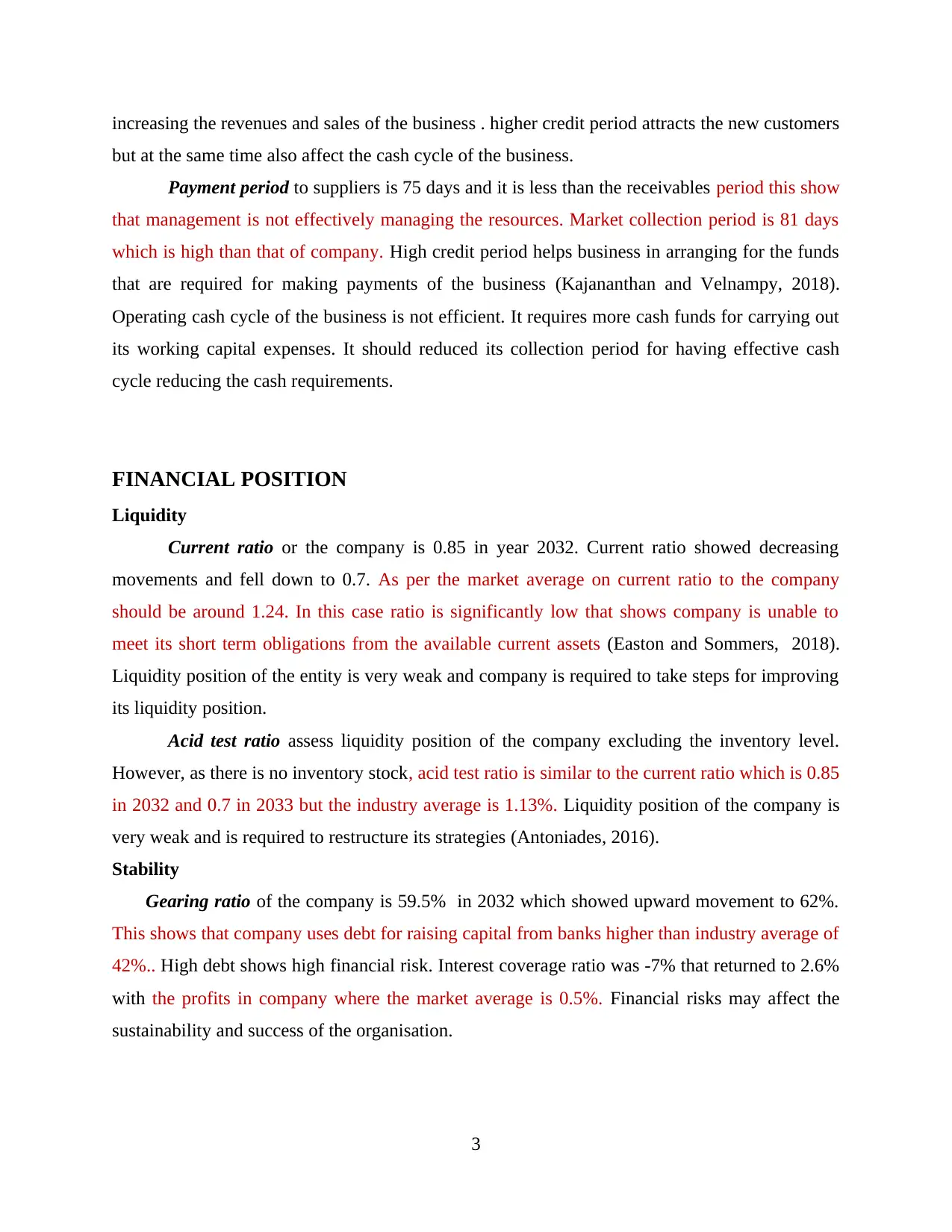
increasing the revenues and sales of the business . higher credit period attracts the new customers
but at the same time also affect the cash cycle of the business.
Payment period to suppliers is 75 days and it is less than the receivables period this show
that management is not effectively managing the resources. Market collection period is 81 days
which is high than that of company. High credit period helps business in arranging for the funds
that are required for making payments of the business (Kajananthan and Velnampy, 2018).
Operating cash cycle of the business is not efficient. It requires more cash funds for carrying out
its working capital expenses. It should reduced its collection period for having effective cash
cycle reducing the cash requirements.
FINANCIAL POSITION
Liquidity
Current ratio or the company is 0.85 in year 2032. Current ratio showed decreasing
movements and fell down to 0.7. As per the market average on current ratio to the company
should be around 1.24. In this case ratio is significantly low that shows company is unable to
meet its short term obligations from the available current assets (Easton and Sommers, 2018).
Liquidity position of the entity is very weak and company is required to take steps for improving
its liquidity position.
Acid test ratio assess liquidity position of the company excluding the inventory level.
However, as there is no inventory stock, acid test ratio is similar to the current ratio which is 0.85
in 2032 and 0.7 in 2033 but the industry average is 1.13%. Liquidity position of the company is
very weak and is required to restructure its strategies (Antoniades, 2016).
Stability
Gearing ratio of the company is 59.5% in 2032 which showed upward movement to 62%.
This shows that company uses debt for raising capital from banks higher than industry average of
42%.. High debt shows high financial risk. Interest coverage ratio was -7% that returned to 2.6%
with the profits in company where the market average is 0.5%. Financial risks may affect the
sustainability and success of the organisation.
3
but at the same time also affect the cash cycle of the business.
Payment period to suppliers is 75 days and it is less than the receivables period this show
that management is not effectively managing the resources. Market collection period is 81 days
which is high than that of company. High credit period helps business in arranging for the funds
that are required for making payments of the business (Kajananthan and Velnampy, 2018).
Operating cash cycle of the business is not efficient. It requires more cash funds for carrying out
its working capital expenses. It should reduced its collection period for having effective cash
cycle reducing the cash requirements.
FINANCIAL POSITION
Liquidity
Current ratio or the company is 0.85 in year 2032. Current ratio showed decreasing
movements and fell down to 0.7. As per the market average on current ratio to the company
should be around 1.24. In this case ratio is significantly low that shows company is unable to
meet its short term obligations from the available current assets (Easton and Sommers, 2018).
Liquidity position of the entity is very weak and company is required to take steps for improving
its liquidity position.
Acid test ratio assess liquidity position of the company excluding the inventory level.
However, as there is no inventory stock, acid test ratio is similar to the current ratio which is 0.85
in 2032 and 0.7 in 2033 but the industry average is 1.13%. Liquidity position of the company is
very weak and is required to restructure its strategies (Antoniades, 2016).
Stability
Gearing ratio of the company is 59.5% in 2032 which showed upward movement to 62%.
This shows that company uses debt for raising capital from banks higher than industry average of
42%.. High debt shows high financial risk. Interest coverage ratio was -7% that returned to 2.6%
with the profits in company where the market average is 0.5%. Financial risks may affect the
sustainability and success of the organisation.
3
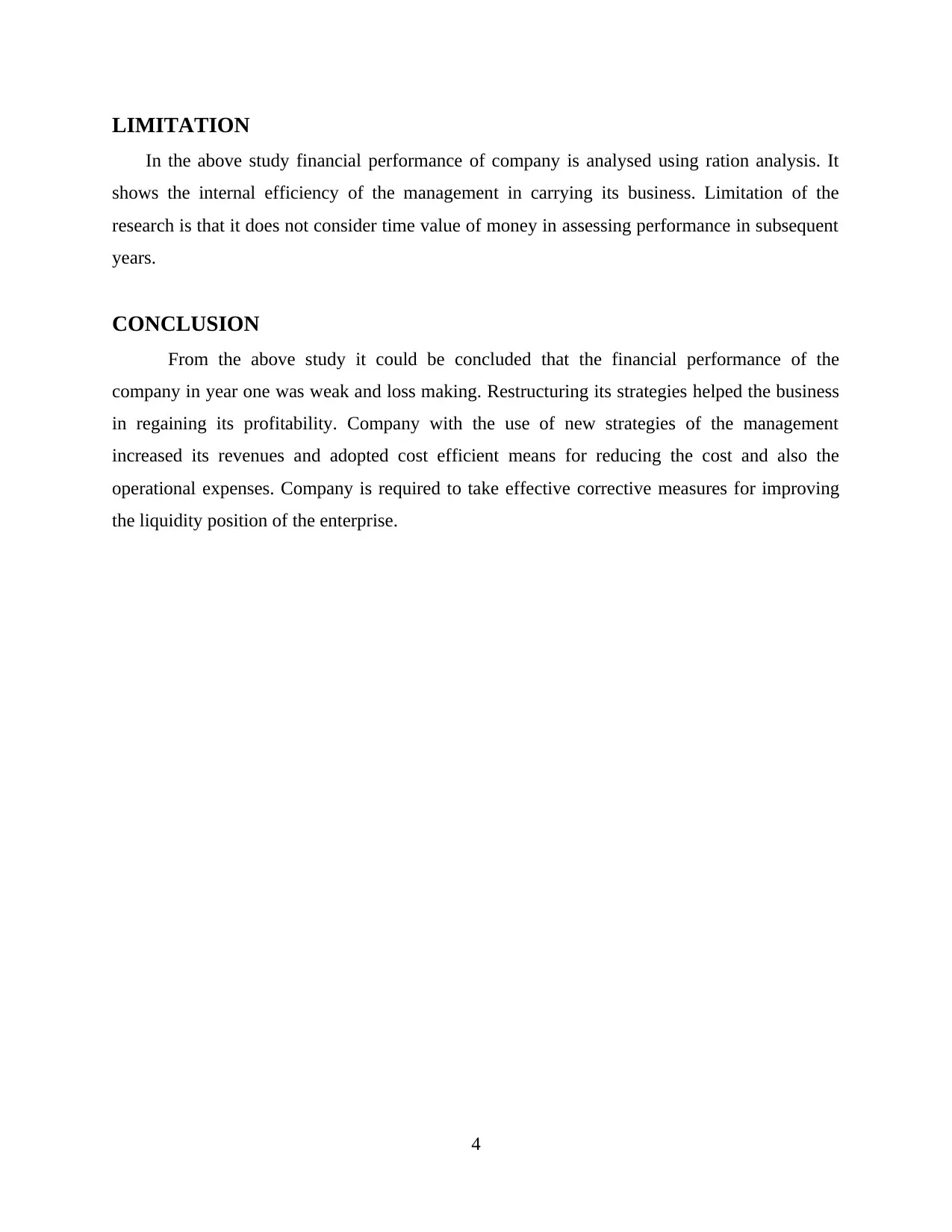
LIMITATION
In the above study financial performance of company is analysed using ration analysis. It
shows the internal efficiency of the management in carrying its business. Limitation of the
research is that it does not consider time value of money in assessing performance in subsequent
years.
CONCLUSION
From the above study it could be concluded that the financial performance of the
company in year one was weak and loss making. Restructuring its strategies helped the business
in regaining its profitability. Company with the use of new strategies of the management
increased its revenues and adopted cost efficient means for reducing the cost and also the
operational expenses. Company is required to take effective corrective measures for improving
the liquidity position of the enterprise.
4
In the above study financial performance of company is analysed using ration analysis. It
shows the internal efficiency of the management in carrying its business. Limitation of the
research is that it does not consider time value of money in assessing performance in subsequent
years.
CONCLUSION
From the above study it could be concluded that the financial performance of the
company in year one was weak and loss making. Restructuring its strategies helped the business
in regaining its profitability. Company with the use of new strategies of the management
increased its revenues and adopted cost efficient means for reducing the cost and also the
operational expenses. Company is required to take effective corrective measures for improving
the liquidity position of the enterprise.
4
⊘ This is a preview!⊘
Do you want full access?
Subscribe today to unlock all pages.

Trusted by 1+ million students worldwide
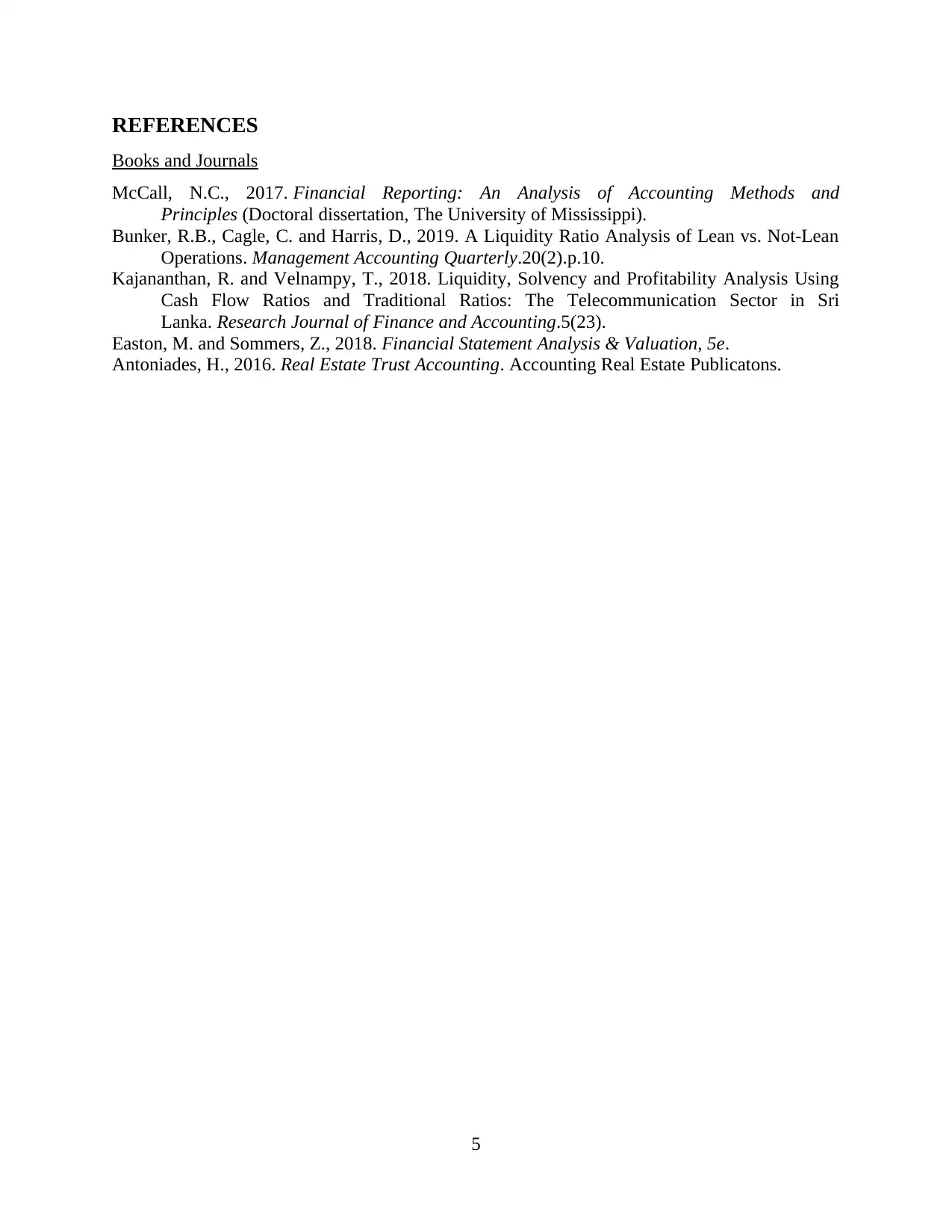
REFERENCES
Books and Journals
McCall, N.C., 2017. Financial Reporting: An Analysis of Accounting Methods and
Principles (Doctoral dissertation, The University of Mississippi).
Bunker, R.B., Cagle, C. and Harris, D., 2019. A Liquidity Ratio Analysis of Lean vs. Not-Lean
Operations. Management Accounting Quarterly.20(2).p.10.
Kajananthan, R. and Velnampy, T., 2018. Liquidity, Solvency and Profitability Analysis Using
Cash Flow Ratios and Traditional Ratios: The Telecommunication Sector in Sri
Lanka. Research Journal of Finance and Accounting.5(23).
Easton, M. and Sommers, Z., 2018. Financial Statement Analysis & Valuation, 5e.
Antoniades, H., 2016. Real Estate Trust Accounting. Accounting Real Estate Publicatons.
5
Books and Journals
McCall, N.C., 2017. Financial Reporting: An Analysis of Accounting Methods and
Principles (Doctoral dissertation, The University of Mississippi).
Bunker, R.B., Cagle, C. and Harris, D., 2019. A Liquidity Ratio Analysis of Lean vs. Not-Lean
Operations. Management Accounting Quarterly.20(2).p.10.
Kajananthan, R. and Velnampy, T., 2018. Liquidity, Solvency and Profitability Analysis Using
Cash Flow Ratios and Traditional Ratios: The Telecommunication Sector in Sri
Lanka. Research Journal of Finance and Accounting.5(23).
Easton, M. and Sommers, Z., 2018. Financial Statement Analysis & Valuation, 5e.
Antoniades, H., 2016. Real Estate Trust Accounting. Accounting Real Estate Publicatons.
5
1 out of 7
Related Documents
Your All-in-One AI-Powered Toolkit for Academic Success.
+13062052269
info@desklib.com
Available 24*7 on WhatsApp / Email
![[object Object]](/_next/static/media/star-bottom.7253800d.svg)
Unlock your academic potential
Copyright © 2020–2025 A2Z Services. All Rights Reserved. Developed and managed by ZUCOL.





